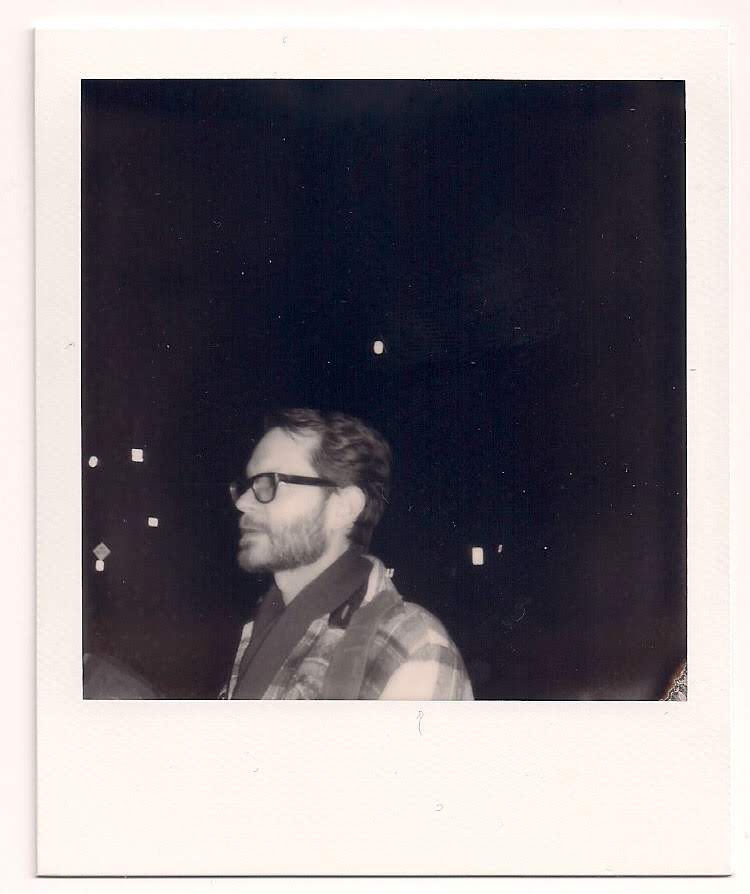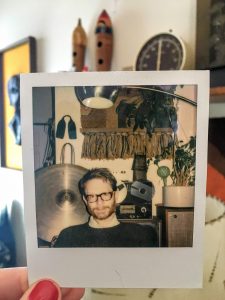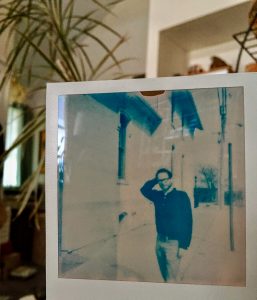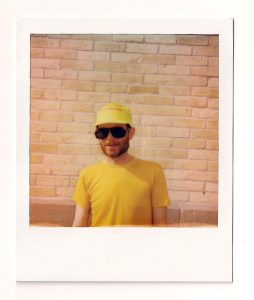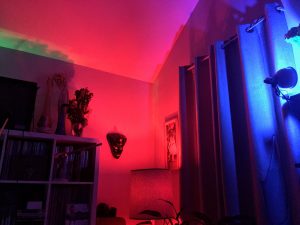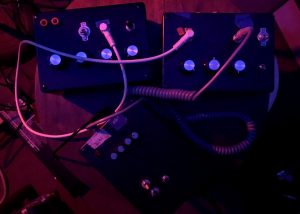Fashion Flesh is the solo output moniker of John Talaga.
According to the artist, instruments used to perform and produce Fashion Flesh albums, as well as the 7″ single, Old Hag / Drawn Apart, a track recorded in one take straight to 4 track tape, sans overdubs, were done using self-built electronics. Those not designed by Talaga were heavily modified beyond audible recognition. No sampling is used, nor sounds sucked from pre-existing sources. The producer eschews soft-synths and plug-ins, even the use of laptops are forbidden, confining himself strictly to analog devices built for specific purposes or, as Talaga likes to say, “dis-purposes”. The result is almost anti-music, with layers of electric minimalism clinging to broken beats, interrupting the disjointed rhythms of Talaga’s soundscapes.
Labels Unknown Precept, Jacktone, EST. 83 (Fit Sound), Vinyl International, White Label, Hiroshima 45 Chernobyl 86 Windows 95 have released Fashion Flesh on vinyl pressings, cassette tapes & digital formats, with the majority of Talaga’s recent releases coming from foreign labels.
I’ve had coffee with Talaga several times and have found him fascinating. He is soft-spoken, thoughtful, and quite humble whenever discussing his music. The following is an excerpt from one of our conversations.
- Images | Francis Spade
Interview | Fashion Flesh
Anthony Brancaleone: Interesting moniker, Fashion Flesh …
John Talaga: It felt abstract enough that people could try to figure it out themselves without any force of suggestion on my behalf. I still think years later that it might be ok at doing that. It feels awkward telling people those words, that name.
AB: And, the philosophy behind your use of handmade analogue equipment to create electronic music?
JT: Every recording has its own process based on my mood that day. Nothing remains the same forever & the perception of everything changes over time. The equipment is just a brush, a pigment or medium, just a crayon or a gelled spotlight to get the feeling or structure sculpted into the track. Sometimes I’ve had to build my own devices to get the result that I’m looking for & it just so happens that I tend to only care to work with analog building blocks. There’s a lot of electro-acoustic one-off instruments I hobble together too, but again it falls under the analog label I suppose. I never really felt like digging into building digital circuits because it always felt digital had a more finite limit to the end object being built; like it only does what it does exactly how it is designed to. Some really early digital things can be groovy too though, it’s not all horrible. Some of the crossover period keyboards & drum machines, things like that from the early eighties can be pretty interesting especially when you do a bit of rewiring. In general I just don’t love the way digital sounds or looks as far as software & computers are concerned, it feels dated in a year’s time to me. It’s like looking at a lithograph compared to a digital print…now look at those two next to each other again in ten years. Some people do well with it for what they want to get across but I stick to tape & most often analog electronics for a lot of different reasons.
AB: Fashion Flesh has a definite ambient quality; what is the optimal time to be listening to your music?
JT: Morning, noon & night all alone or with a stranger. Whenever you want to is the obvious answer & the best one I have. I like to work out ideas & record at any time in any 24 hour span so it’s hard for me to only envision night or day as the optimum time to listen in. I do think there is definitely a difference in how the recordings are perceived when heard at different times, altered mindsets. I like all hours & all circumstances & sometimes the oddest timing is best.
AB: Altered mindsets … do you use stimulants to get in the right frame for producing?
JT: Coffee & plants are stimulating.
AB: Tell us a bit about your studio, equipment, and how you go about creating.
JT: There’s no real set layout or process from one day to the next aside from always recording to tape. Everything is constantly being moved around in & out-of-the-way, there are always things lying about. Sometimes it’s mono, sometimes 2-track/stereo, often 4 track. Reel to reel or cassette, sometimes 8-track tapes. The equipment I use is really only dependent on what I have in mind that day & what I have on hand. Half broken cheap amplifiers, homemade key-less synths & rhythm machines to broken ceramics, plastic bags & everything in between. I use a lot of things that most people consider junk.
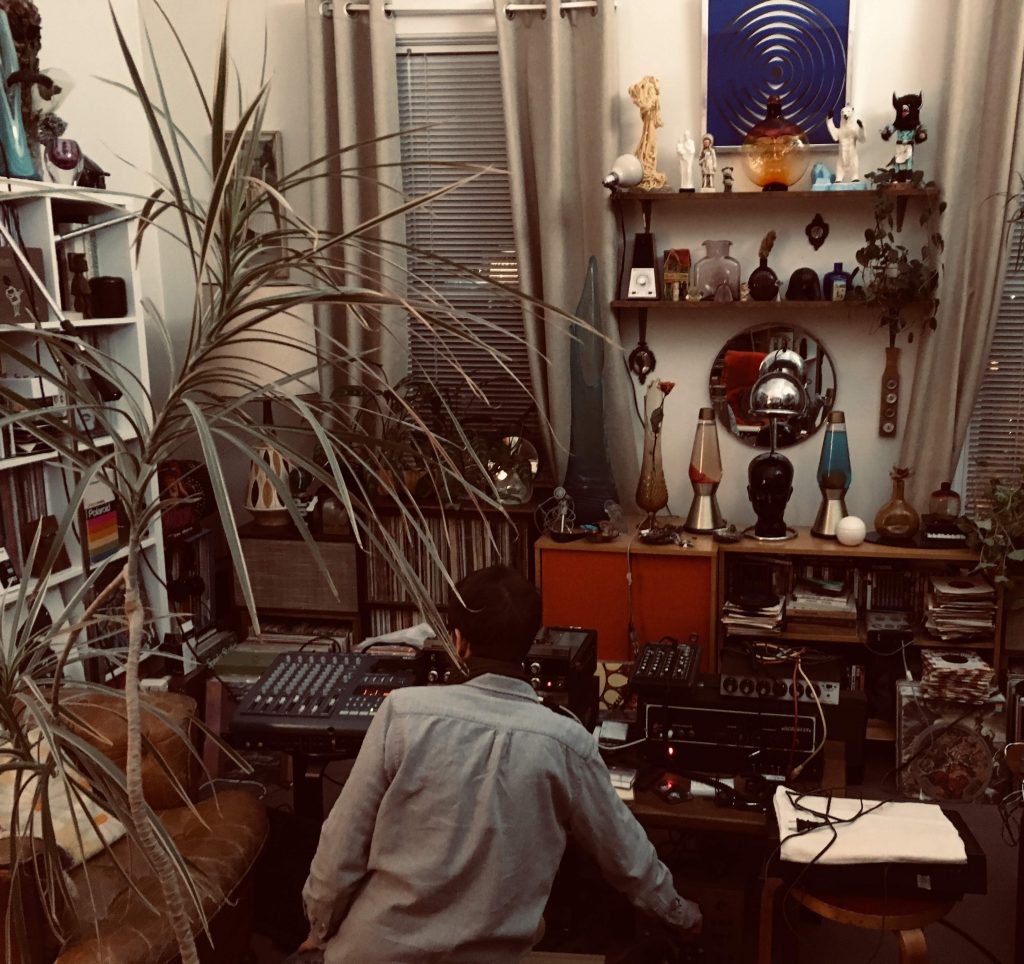
In Studio with Fashion Flesh | by Francis Spade
AB: Why this approach, and what does it say about what most people consider “junk”?
JT: It really all depends on what sounds I want to include. I’ve never been attracted or inspired by the experience of buying new equipment at a musical instrument shop. Most of the instruments that I have picked up typically have been rather used & often abused by the time I found them. This has never been a sad thing to me, instead it made it plausible to fix things or alter them heavily without any self-imposed limitations. Quite often I’ll fix them incorrectly or in a new way, rewired with no service manual.
AB: Tell me a bit about your favorite pieces of equipment.
JT: I think my favorite things are probably a few of the first nameless electronics I ever built myself with no real skilled knowledge of circuit design. They somehow have managed to live through many clumsy drops, water damage & spills, careless baggage handlers crushing them into the mangled walls of checked luggage & countless batteries exploding inside. But really it changes every day, no real definitive favorites.
AB: You have a good deal of material, three full albums, singles, collaborations, and you’ve sent me a folder filled with unreleased tracks (which, I love); what is your recording schedule?
JT: For nearly 20 years I recorded a new piece almost every single day. Now I think likely around 15 recordings a month or so, possibly a few less.
AB: Where do you find inspiration to produce that much material?
JT: My girlfriend’s cats, the weather, chipped paint, the majority of things that influence me the most are generally outside of music. In every single surrounding thing there is a billion little details that I can hang my mind on for hours. Inspiration can be anything but most often is not from another song/painting/film. I don’t want to steal from anyone’s vision because I don’t see the point in it. The process is always changing as often as my mood & it always relies on spontaneity. The action is the process. The recorded happening is the result.
AB: But, you are listening to other artists …
JT: Some recordings I listen to more than others are by Les Baxter, Piero Umilliani, Ken Nordine, Cluster. I really like a lot of private press LPs & 7″s that I never knew existed before, finding them in some random dollar bin or junk shop.
AB: Who do you recommend that we may have missed over the years?
JT: It’s hard to name any particular people or bands to be aware of specifically because everyone has their own likes & hang-ups. Just listen to everything & keep listening to what draws you in more often on repeat. But if I had to pick one person that everyone should be aware of it would be Gary Wilson. Not only is he an extremely interesting artist for many decades now but also a wonderful person all around. Listen to Gary.
AB: Have any thoughts on the current state of music and the music industry in general? Is it a good time for indie artists?
JT: I’m kind of cave dweller in terms of the current state of music, not aware of the overall picture. I don’t feel like I really know if a good time ever exists compared to another.
AB: How do you finance your projects?
JT: It’s basically impossible for me to finance my completion of a release on my own, getting something pressed to vinyl. I’m definitely thankful to work with record labels that are willing to take on that burden. There’s always a persistent nagging need to find more fitting outlets because the costs of releasing records can be pretty heavy for one independent label to take on alone.
“It’s all folk art, really”
AB: Your music and, in fact, the way it is created, seems rather complex. As a producer are you hoping your audience “gets it” or is it designed for listeners to have their own experience?
JT: I only make things that I enjoy & never want to suggest how others will perceive it. Everything is personal in that sense. I still feel happy when others enjoy it too.
AB: Do you believe in aliens, ghosts, the paranormal?
JT: Yes. I believe in space, energy & also in other dimensions.
AB: Because, much of your music seems to play with space and dimensions, layers, aural soundscapes, and the like – is there a relationship?
JT: I meant outer space & fourth, fifth, sixth, etc dimensions.
AB: So did I.
JT: Things living on & in other rocks or planets elsewhere seem more likely than not to me. Maybe the most advanced beings are colors or gases or whatever instead of some unimaginative humanoid form that everyone likes to believe…maybe ghosts are just trapped blasts of energy or emotions, possibly stuck on repeat. There’s likely many other dimensions right here that are completely invisible to our sensory perception. Hallucinations exist so why isn’t it also possible that not all hallucinations are not something else? A fleeting glimpse of a new sensory perception. Obviously I don’t really know but I do think about these things. As far as trying to build a space & aural moving picture to set off listener’s synesthesia or something like that, yes.
AB: I knew it … Can you explain the conceptual differences between ‘albums’ and help us to identify what if anything makes them separate pieces of work.
JT: Every album is like another collection of paintings to me, like an exhibition or maybe a book with different chapters or paragraphs or pages. Usually an album is made up of pieces that were recorded during the same time span, so the concept & feeling overall tends to form itself.
AB: How does an electronic musician evolve over each project?
JT: I don’t really consider myself an electronic musician. It’s hard to say, but I think nothing necessarily must be done specifically to evolve. It just happens naturally. If anything I think going into it with preconceived notions or forcing a false sense of evolution is a great formula for failure. It’s all folk art really.
AB: If you don’t mind sharing your thoughts I’m going to run a few artists by you: Derrick May
JT: I dig the hands on approach to the recordings of Derrick May that I’m familiar with, which are mostly his early 12″ releases, things like Nude Photo. The sounds being shaken into the form & structure of the track, kind of funky & fluid, that’s what I like about it.
AB: Eno
JT: Eno I really like both in Roxy Music & on his own earlier recordings.
AB: How about EDM, in general?
JT: A lot of the computer based or aided recordings end up having the same effect & feeling on me that computer generated monsters & landscapes in movies do; they feel really fake & cheap like a temporary tattoo out of a vending machine or a breakfast cereal commercial. Everyone can see & hear that new fad software shift in a year or two from the point in time that it was created, if not directly in style at the very least in res. I prefer a person in a rubber monster suit any day because it’s still a real object with light bouncing off of it, everything digital becomes Shrek. Same thing with the sound of acoustics or voltage or whatever. Of course if that’s the effect you are trying to achieve, something that is dated or will sound dated by technology then that can work too. It’s all a personal taste thing & maybe I’ll appreciate that sense of software tackiness that is easily achievable later on, but I don’t see it gaining the same warm nostalgia that something like bell bottoms or MCM furniture has earned overtime. I just limit myself in that way by choice & don’t pay much mind to things that I don’t love as much. In no way do I mean to insult people who like it but I just don’t love it.
AB: The Bay City Rollers are clearly the best bubble gum pop band ever to reference a Michigan town – help us to understand their genius …
JT: Their pre-grunge era visionary use of plaid & flannel.
When not producing tracks from his studio in Bay City, Michigan the work of John Talaga can be found on collaborations with Matmos, Electrosexual, Cornelius, Stereo Total, TSR 80 and Momus.
Photography | Francis Spade

